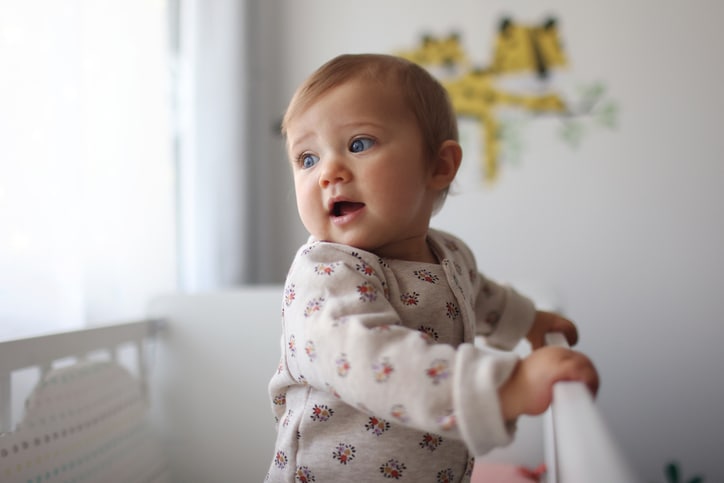There’s probably nothing more stressful and confusing to many parents and caregivers than baby sleep. From how to get a baby to sleep through the night to how often they should feed at night, many parents and caregivers are filled with questions about baby slumbering habits. One pressing question that can have a major impact on a baby’s comfort and safety is how to dress a baby for sleep.
“Sleep clothing plays a crucial role in safe sleep for babies by helping to regulate their body temperature and reduce the risk of SIDS,” says Dr. Anna Cornish, director of ambulatory general pediatrics at Staten Island University Hospital.
The basic principles for how to dress a baby comfortably and safely are that caregivers “should dress their baby in lightweight, breathable clothing that is appropriate for the room temperature,” Cornish adds. Here, we’ll explore the ins and outs of dressing babies for sleep, including expert input on the safest and most comfortable baby sleep clothes to choose.
How clothing and other factors influence baby sleep
Part of the reason that infant sleep can be so bewildering to parents and caregivers is that it’s constantly evolving. “Sleep changes dramatically as an infant opens their eyes for the first time and continues through the months of tireless exploration that lead up to their first birthday,” says Dr. Robert Quillin, board-certified pediatrician and medical director at Pediatrix Newborn Services of Texas.
“Sleeping is an important part of the baby’s development,” says Dr. Matthew Deng, pediatrician at Northwell Lenox Hill Hospital. Newborns typically sleep about 16-18 hours a day and do this sleeping in shorter stretches, he explains. “As babies grow and develop, their total hours asleep will decrease slightly to around 12 to 16 hours a day, including naps. They will also sleep in for a longer period of time.”
Read more:
Several factors affect how well and comfortably a baby sleeps, including how well-fed they are, whether they had a stressful or overstimulating day, developmental changes they may be experiencing — and comfort, including how they’re dressed. Sleep patterns follow genetics as well as environmental cues, Quillin says.
How to dress a baby for sleep
When you consider how to dress a baby for sleep, safety should be top of mind. “It is important for parents to create a safe sleep environment for their baby to reduce the risk of Sudden Infant Death Syndrome (SIDS) and other sleep-related risks,” says Cornish.
Each year, about 3,400 babies die as a result of sudden unexpected infant death (SUID), which includes SIDS, deaths from unknown causes and accidental strangulation and suffocation during sleep, according to the Centers for Disease Control and Prevention (CDC). The sleep environment you provide for babies, including how you dress them, plays an important role in SUID prevention.
In addition to always putting babies to sleep on their backs and keeping the sleep area clear of suffocation hazards, the American Academy of Pediatrics (AAP) recommends the following clothing-related guidelines for safe sleep:
- Don’t overdress your baby for sleep.
- Don’t let your baby get overheated.
- Don’t use hats for babies indoors or while they sleep.
What is the safest sleepwear for infants?
Overheating is a major safety concern, so Cornish advises that dressing babies in light, breathable clothing is best. The experts we spoke with recommend the following as the safest options for baby sleep clothes:
- Lightweight cotton onesies.
- Sleep sacks.
- Wearable blankets.
As your baby moves past the newborn months, Dr. Ilan Shapiro, chief health correspondent and medical affairs officer at AltaMed Health Services, says you can add footed pajamas to the repertoire, particularly if the temperature in the room is cool.
“Watch for overheating and remove layers with warmer temperatures.”
—Dr. Anna Cornish, director of ambulatory general pediatrics, Staten Island University Hospital
Additionally, don’t forget that babies prefer anything that reminds them of when they were safe and comfy in the womb. “Recreation of the womb environment is a great way to think about how to keep babies sleeping comfortably — babies love feeling cozy either in a swaddle or sleep sack,” Deng adds.
How many layers should babies wear to bed?
It can’t be emphasized enough that you don’t want to overheat a baby during sleep because that’s a major risk factor for SIDS. As such, even on cold nights, the AAP recommends dressing babies in no more than one additional layer of clothing than you would wear yourself.
It’s recommended that you don’t use blankets, pillows or other loose bedding in a baby’s sleep space because these can pose suffocation or strangulation risks. “Opt for sleep sacks, swaddles or wearable blankets instead to keep your baby warm and safe while they sleep,” Cornish offers. However, she says, “watch for overheating and remove layers with warmer temperatures.”
How to choose the right baby sleep clothing
Beyond which clothes types to focus on, there are various other factors to consider when it comes to how to dress a little one for sleep. Here’s what our experts say:
1. Consider fabric type and breathability
Fabric type matters when it comes to baby clothing. “Try to opt for breathable, soft fabrics such as cotton or bamboo that are gentle on the baby’s skin and help regulate body temperature,” Cornish recommends. “Avoid synthetic fabrics that may cause irritation or overheating.”
Choosing breathable materials like cotton prevents babies from overheating, Shapiro says. “Also, remember that babies have sensitive skin, which is why it’s important to avoid rough materials that could irritate the baby’s skin,” he adds.
2. Take the season into account
A baby’s clothing needs will change as the weather changes. Cornish recommends choosing clothing that’s appropriate for the seasons as well as the temperature in your home. “In colder weather, opt for thicker, warmer sleepwear,” she says. “Lightweight, breathable options are best for warmer weather.”
Don’t forget to consider the temperature in the baby’s sleeping area as well. If the room is a reasonable temperature, thicker clothing may not be needed. “In terms of temperature, anything you feel comfortable being in will generally be comfortable for the infant as well — this tends to be around 68-72 [degrees Fahrenheit],” Deng says.
3. Pay attention to size and fit guidelines
Choose clothing that fits the baby properly, not only so it’s comfy, but so that it’s safe. “Ensure that the sleep clothing fits your baby properly to prevent any suffocation risks,” Cornish advises. She recommends staying away from any clothing that is too tight or too loose.
4. Prioritize safety features
Baby clothing often comes with features like snaps and zippers, which can make it easier to change your baby on the go or in the middle of the night. But it’s important to shy away from zippers that are poorly placed and could get near the baby’s nose or mouth, Deng advises.
If you notice that a baby’s skin is irritated or chafed by a snap or zipper, Shapiro recommends opting for a different clothing item. “It’s also important to avoid decorations that can detach and pose choking hazards around the baby,” Shapiro says.
5. Prep sleep clothing before using it
It can be tempting to put brand new clothes on a baby without washing them first, but Quillin recommends against that. “Pre-washing any infant clothing will prevent skin irritation,” he says. He also recommends removing stiff clothing tags, as doing so will enhance comfort and promote more satisfying sleep.
The bottom line
If you have questions about how best to dress a baby for sleep, it can be helpful to reach out to a pediatrician for guidance, as they are familiar with the baby’s individual needs. Above all, when it comes to how to dress baby for sleep, parents and caregivers should prioritize both comfort and safety. Thankfully, the two usually go hand-in-hand.
“By considering factors such as fabric type, seasonal variations, size, safety features and toxin-free materials, parents can create a safe and cozy sleep environment for their babies,” Cornish concludes.






